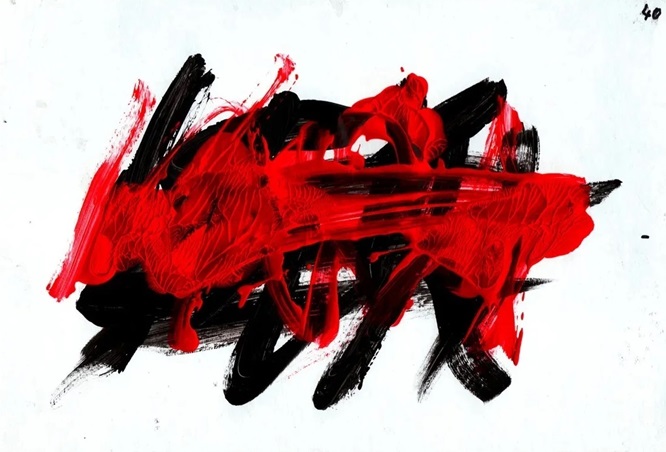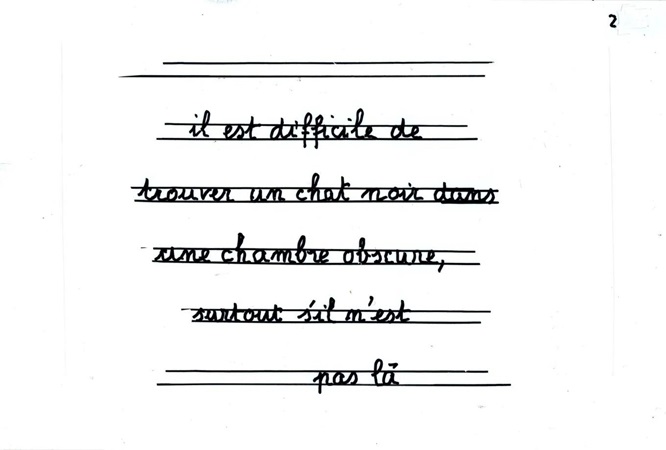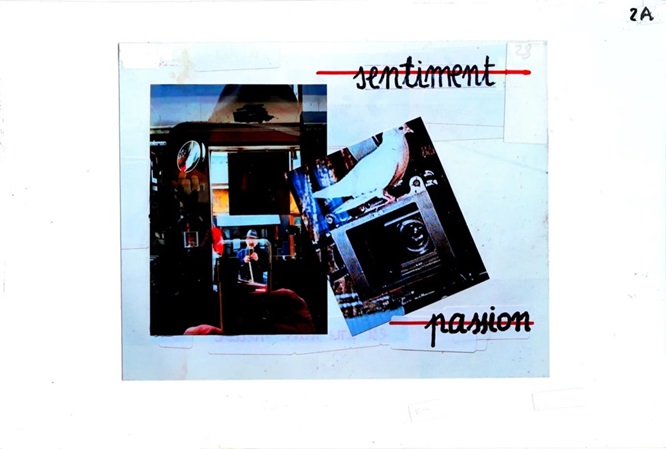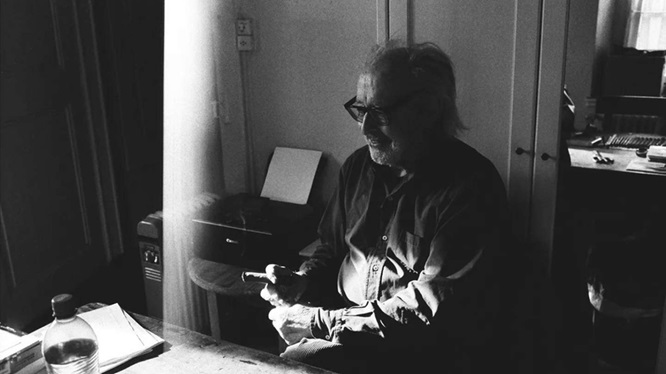

[Saint Laurent Productions / Vixens / L'atelier]
Jean-Luc Godard died at the age of 91 by assisted suicide. The last scene he directed. Eight months later, his final film was unveiled at Cannes. It is a sober effort, with long periods of silence and a steady progression of still frames. Film annonce du film qui n’existera jamais: « Drôles de guerres » (“Trailer of the Film That Will Never Exist: ‘Phony Wars.’”) is a 20-minute short that allows the famous director to speak from the grave.
As he muses in the film, with the trembling remains of his well-known voice, “When I told [fashion house] Saint Laurent that I would actually like to make a movie just like Plisnier, who returned to his political and revolutionary love affairs, I asked myself: ‘could I make another movie?’” It was going to be a feature called Drôles de guerres, based on Charles Plisnier’s award-winning 1937 novel Faux passeports (False Passports). What drew Godard to the writer’s work, as he points out not once but twice, are the Belgian’s crossed beliefs. He is tossed from the Communist Party for “deviancy” (a treasured quality in the Godard lexicon of belief), and so, becomes a Communist who is not a Communist. Plisnier returns to “his old love, revolutionary politics,” the same way that Godard returns to his old love, the cinema.
The first image shows only erasure, a large black and red scribble. Something has been written and then covered over with a dark smear. What we need to see cannot be shown. But we can point to the efforts made to obscure it, even the holes it has produced, the absences which surround it, like the echo of a hard shoe stepping down a hallway. Perhaps we can recreate the hallway from that echo because it is all that is left of a life worth living.
“…a listening less to what is articulated in language than to the void circulating between its words, to the murmur that is forever taking it apart.” [1] — Michel Foucault
The Swiss maestro never stopped working. More than a virtue or ideal, it has been central to his life. To live is to work. So perhaps it’s no surprise that he expected the same from his frenemies: the audience. No one works harder in the cinema than the audience of Jean-Luc Godard.

A series of numbered cards appear. They are mostly white, each featuring an image or image collage. Sometimes a handwritten text fragment. I remember Stan Brakhage saying that, if he were stranded on an island, he would scratch his cinema onto rocks. Here, Godard creates desktop collages out of painting reproductions, photographs and quotations. These scraps and fragments lie together, inviting the viewer to ponder their relationship. What code will unravel the mystery? Or is the mystery itself central to what is on display?
One of the gnomic statements that Godard enjoys inserting into his work arrives in a handwritten note, neatly written in a schoolboy’s primer. “It’s hard to find a black cat in a dark room, especially if it’s not there.” If the dark room is the cinema, then the black cat must be Godard, or, of course, ourselves. The quote is routinely misattributed to the mythical figure of Confucius, though the author is unknown. Perhaps what is missing, even in our own lives, is the author. And how could it be otherwise, in a movie released after the author is dead?
Image 6 shows a mother and her three children. The child in her arms is a smudge, as if every trace of the future were uncertain, even improbable. Every face is worn to near erasure, they appear as survivors of a forgotten war, clinging to existence. Who will put their body in the place where my body was? Who will remember me?
Image 7 offers three pictures. Nosferatu approaches to drink the blood of a sleeping woman. A woman soldier bows her head, a partisan fighting enemy occupation. And finally, there is Paul Cézanne’s painting Le garçon au gilet rouge (Boy in a red waistcoat) made in 1890. What could we make of these three figures—the vampire/sleeper couple, the exhausted partisan and the melancholy boy? The fight against the invaders is too intense, they seem to work even when we are sleeping, in the land of our dreams. They have manufactured our past and future, turning us into moody and isolated children.
Here is John Elderfield on Cézanne’s portraits. Though every time he writes “Cézanne” I read the name “Godard.” “These paintings often seem to question the very aim of portraiture. They reveal little about the personalities of their subjects, whom they refuse to flatter. Nor, as with portraits of his wife, do they always resemble the sitter. Cézanne’s radical methods of building solid structures by means of shimmering colour, geometric form, and line—most famously in his landscapes and still lifes—proved especially shocking to audiences when applied to faces. Nevertheless, the vivid human presence in Cézanne's portraits contradicts a long-held idea that he painted people no differently than he did apples.” [2]

In card 10, Godard takes an image from “the Ansel Adams of Argentina,” [3] Pedro Luis Raota (1934-1986). It shows three children sitting on a stone wall, while a fourth takes a photograph of a duck. After blowing out the colour with maximum saturation and contrast, Godard accompanies it with a brief handwritten text: “But the bottom line is that there are no grown-ups.” The production of images has been left to children, whose aim is to domesticate the wild, no doubt an echo of their own schooling.
Card 11 is about betrayal, one of the most important threads in the director’s epic Histoire(s) du cinéma (266 minutes, 1988/1998). The first of these betrayals is that cinema was unable to prevent the Holocaust, though images were made and delivered to the Allies that clearly showed the transports that delivered Jews to their death. The second, as Jacques Rancière writes, is that cinema “betrayed its vocation by sacrificing the fraternity of metaphors to the business of stories. By detaching metaphors from stories in order to fashion a different ‘history’ out of them, Godard fashions the cinema that has not existed. But he does so by means of video montage.” [4] Here, in his weakened and reduced state, already making plans for his death, Godard “fashions the cinema that has not existed” out of poor images downloaded from the net, and quotations from a lifetime of reading.
Card 15 shows the Marxist mystic Simone Weil, the woman who worked herself to death in solidarity with the working class. While she lay dying, she refused food, arguing that she should eat no more than the starving partisans in her home country of occupied France. A blue-tinted image of a woman, her face nearly erased, appears below the title Le bleu du ciel (1935), the Georges Bataille political/erotic novella. It features Lazare, a character based on Weil, who prepares herself for torture and death at the hands of Franco’s troops in the event of her capture. Bataille waited until after Weil’s death to publish the book, more than twenty years later. He had already been tossed out of the surrealist group by André Breton, marking him as a surrealist who was not a surrealist.
With a simple phrase and an almost erased photograph, Godard sets into motion a restless flow of associations, an extended family of ideas. The complicated identities of Weil and Bataille, their leftist political commitments, the fact that they stood apart from organizations or movements that might have provided them an easier home, mark them as singular figures of resistance. For Godard, they remain an irresistible couple.
Without warning, the film bursts into movement. A young woman runs across the screen, thin and French. How else to see the motion in a motion picture, unless it is surrounded by stillness? We overhear a conversation between Godard and his producer concerning the film he’s not going to live long enough to make. These scenes have appeared many times in Godard’s films, each echoing Jerry Prokosch in Le mépris (Contempt, 1963): “When I hear the word ‘culture,’ I take out my cheque book.”
You can feel Godard reaching, in every card and aphorism on display, for a new way of thinking, and a new kind of cinema, a cinema that might begin again for the first time, leaving behind its capitulations to the ruling class. In order to make this possible, he emphasizes that every revolution begins with relationships, sometimes between a stubbornly iconoclastic film and its avant audiences, between the worn-down images and melancholy texts, between the French resistance of the Second World War and artists today who refuse every standard of practice and reply. Godard remains cinema’s most famous contrarian. He was born to say no. Little wonder that even the esoteric marginalia of Drôles de guerres is filled with new ways of making and thinking cinema. It is invitation and affront. Will you join him there?

[1] Michel Foucault, The Birth of the Clinic, (London: Routledge, 1973), 154.
[2] John Elderfield, et al., Cézanne Portraits (London: National Portrait Gallery, 2017).
[3] http://www.photographywest.com/pages/raotabio.html
[4] Jacques Rancière, The Emancipated Spectator (London: Versa, 2009), 130.
*
Mike Hoolboom began making movies in 1980. Making as practice, a daily application. Ongoing remixology. Since 2000 there has been a steady drip of found footage bio docs. The animating question of community: how can I help you? Interviews with media artists for 3 decades. Monographs and books, written, edited, co-edited. Local ecologies. Volunteerism. Opening the door.
 |
envoyer par courriel | 
| imprimer | Tweet |
